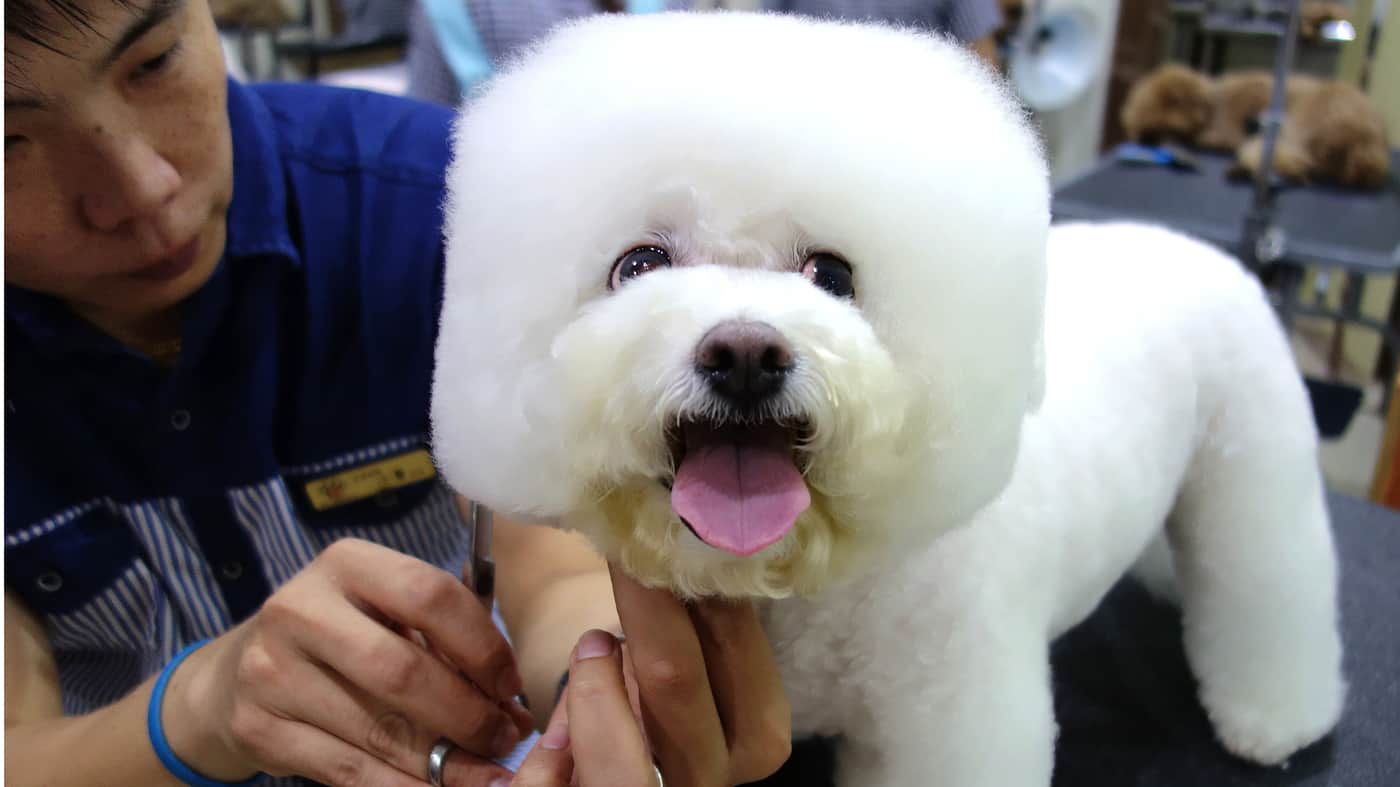The rectangular head style is normally found on terrier breeds and some working dogs. There are minor differences between breeds in the length and density of the rectangle that stems from the bone structure of the dog. Beard length is another controlling factor.
For most of these breeds, the top skull is closely trimmed to show off the level line of the head between the ears. Dogs with exaggerated brows are trimmed closest, about the length of a No. 10 blade used with the grain.
Small triangular brows traditionally have a bit more coat on the top of the head —the amount produced by roughly a #7F blade used with the lay of the coat. On dogs with falls, clipper length varies from close trimming on the top of the head as on the Kerry Blue, or to the Wheaten, which has the longest coat left on the top of the head, up to a full inch. Even with the longer coat on the Wheaten Terrier, the line between the ears is still straight when viewed from the front.
The general lines for clipping the neck, throat and cheek vary slightly, but all clear the throat area enough to show off a moderate length of neck that is powerful. Typical blades used to clip the neck, throat and cheek range from a No. 15 to a medium sized attach-on comb for the Wheaten.
Dogs with exaggerated brows usually are clipped shortest, while short-browed dogs are a bit longer. Again, the dogs with falls vary. The Kerry is done very close, the Sealyham is a bit longer and the Wheaten goes the longest.
The line for the cheek starts just behind the eye and follows the bony ridge straight back to the ear canal. The line that establishes the beard starts just behind the back corner of the eye and runs on a diagonal toward the back corner of the mouth. On some breeds, the line will stop before the mouth, on others it goes right to the mouth.
Certain breeds have heavier goatees than others, but the general rule of thumb with all of them (other than the Schnauzers and the Soft Coated Wheaten) is that the line under the chin that forms the goatee is brought slightly farther forward than the back corner of the mouth.
With the Schnauzers, the basic lines of the beard and goatee are set by the three whisker nodulars found on the muzzle, two on either side of the cheeks and one under the jaw. The throat and neck line starts at the base of the ear, or ear bulb. It drops to a soft “V” with the bottom of the “V” resting a few inches above the breast bone; the larger the dog, the greater the distance.
The coat on the muzzle that makes up the beard and goatee vary in length from breed to breed. The coat under the eye area is never clipped as this hair forms one of the critical lines of the classic rectangular head style. The line on the dog’s face should be straight, from the flat cheek down into the beard area.
Double check this line by laying a greyhound comb along the side of the head. Any fur that sticks out beyond the comb should be removed. Any hair inside this line needs to remain and be blended to create the rectangular shape.
On dogs with long, natural beards, the lines making up the head are sharp, crisp and clean. On the shorter beards and brows of the harsh coated terriers, the lines are blended to be invisible. Check this line by holding the beard and goatee coat in your hand, holding it out of the way. Look for stray or long hairs at the junction of the clipped areas on the checks and throat and the beard/goatee. Make sure the line is neat.
Tips to Set a Rectangular Head
- Use the eye socket ridge to set the brow. This will help in getting them even.
- On dogs with short brows and harsh coats, clip the top skull with the lay of the hair for better blending.
- For dogs with long beards and exaggerated brows (except on the Wheaten), use a No. 7F – No. 5F or No. 4F blade in reverse to set the lines over the brows or fall.
- On long brows and falls, line the shears up between the back corner of the eye and a point on the nose. For the second eye, line up the points only from the first side to get brows and falls similar in size and shape.
- Use curved shears in reverse to set long brows and falls.
- Trim small brows with thinning shears to eliminate a sharp line, allowing the brow to accentuate the piercing expression of the dog, but blending with the overall look of the haircut where all lines are blended and invisible.
- On dogs that have shorter beards and brows, shorten the longer hair in the muzzle area by raking a No. 1.5 or No. 1 attach-on guard comb over the beard area. Feather off over the end of the muzzle to extend the length of the rectangular head.
- With long exaggerated brows, remove the cowlicks that are found just at the inside corner of the eye, otherwise the brows will cross over one another.
- On long-bearded dogs, hold the entire beard in your hand and check the line between the long coat and the clipped throat and cheek areas.
- With short-bearded dogs, blend the transition line between the cheeks and the beard with thinning shears to help create an invisible line.

